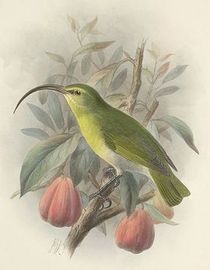Greater Akialoa
The Oʻahu ʻAkialoa was a species of finch in the Fringillidae family. The Oʻahu ʻAkialoa was a species of Akialoa, or long-billed insectivorous bird that was that was found in the high elevation forest. It was a dull colored species, dull green on the belly, bright green on tail on rump and tail, dark olive-grey back and speckled yellow and green on the head. It was endangered from the loss of habitat; it was very prone to Avian Flu, a disease that was introduced by the mosquito. This bird was mainly an insectivore using its bill to probe through the bark in search of bugs to eats. It also used its long bill to go into flowers to reach their stores of nectar. When the forests are cleared the bird could not find any food, as a result, they would starve. The birds were also weak against the natural diminishing factors like weather and competition from other native nectar feeding birds. Scientists were sure that this bird was still common in the 1860’s, evidence found by Perkins. Afterward, few reports came in,
The Greater Akialoa is classified as Extinct (EX), there is no reasonable doubt that the last individual has died.
The Greater Akialoa was a large bird growing up to 19 centimetres (7.5 in) long. Its bill took up to a third of the body length. The species had three forms, confined to Lanai, Oahu and Kauai respectively. It did not include the much smaller Hawaii Akialoa, which was considered a full species. The Lanai and Oahu forms are extinct, while there is a remote possibility that the Kaui form survives. Stub icon This Fringillidae-related article is a stub. More

Family : Fringillidae
Genus : Hemignathus
Species : ellisianus
Authority : (Gray, 1859)

